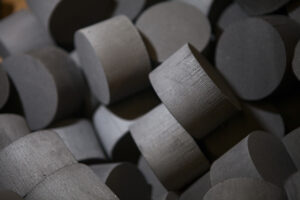Materials
Urethane & Olefin Foams
Open cell polyether and polyester foams
- Viscoelastic foams for reduced pressure conforming comfort
- Melamine foam for temperature resistance up to 300 degrees Fahrenheit
- Cast urethanes and sponge rubbers for gasketing
- Fluid handling applications such as synthetic sponges, water absorbers and ink pads
Closed cell materials
- Polyethylene for packaging
- Polypropylene for lightweight structures
- Cross-linked polyethylene for harsh environments and fine surface protection
- EVA for athletic padding
Polyurethane foams
- Polyether, polyester, and graft polyol foam provide a wide range of solutions in comfort, filtration, and acoustic management
- Reticulated foam provides controlled pore sizes from 5 to 95
- Felted reticulated foam has high capillary action and acts as an excellent liquid reservoir
Polyolefin foams
- Closed-cell foams including polyethylene and polypropylene are lightweight and tough, yet provide excellent protection and insulation properties
Specialty foams
- BASF’s Basotect melamine-based foam
- Rogers Corporation’s cast urethane Poron and silicone Bisco
- Memory foam
- Hydrophilic foam
- Double-cell foam
Elastomeric Foam
 CR / Polycholoroprene / Neoprene
CR / Polycholoroprene / Neoprene
A general-purpose rubber that has good:
- Elasticity, flexibility and stability in a wide temperature range
- Solvent resistance
- Thermal and electrical insulating capability
- Natural resistance to burning
ECH (Epichlorohydrin)
ECH is a relatively expensive rubber with uses that include gaskets for automotive fluids and business machines with exposure to print toner. It has:
- Good high temperature resistance
- Good cold flexibility
- Excellent resistance to oils, acids, alkalis and ozone
EPDM (Ethylene Propylen Dien Monomer)
First marketed as “crackless rubber,” EPDM has excellent resistance to ozone and heat. The ratio of the 3 main components in the final compound allows custom blending for a wide range of applications. Unfortunately, EPDM has very poor resistance to hydrocarbons, including oil and gasoline. It also has poor resistance to concentrated acids.
Latex / Natural Rubber
The original “foam rubber,” Latex is highly resilient and has excellent fatigue properties both in terms of firmness retention and resistance to height loss.
NBR / Buna-N / Nitrile Butadiene Rubber / Nitrile
A highly resilient material that is more resistant to oils and acids than natural rubber, but not as flexible. It keeps its physical properties over a wide temperature range. Typical applications include fuel and oil hoses, footwear and fluid seals.
PVC (Poly Vinyl Chloride)
PVC is relatively inexpensive material that has good thermal insulating properties, flexibility, and resistance to weathering. It also has a relatively low maximum operating temperature and high abrasion resistance. Unfortunately, PVC can outgas acidic vapors in hot, humid environments and plasticizer stability can be a problem in contact with rubber based adhesives.
SBR (Styrene Butadiene Rubber)
SBR is an inexpensive replacement for natural rubber with excellent resistance, flexibility and toughness. By changing the proportions of the 2 main ingredients, a wide range of physical properties can be achieved. SBR is often blended with other synthetic rubbers to produce more cost-effective blends.
VN (Vinyl Nitrile)
A common blend of PVC and nitrile rubber materials, which is sometimes called “modified PVC.”
Rogers Foam also works with a range of non-foam materials, including fabric and nonwoven, fiber, fiberglass, foil, aerogel, PCMs, adhesives, and wood.
